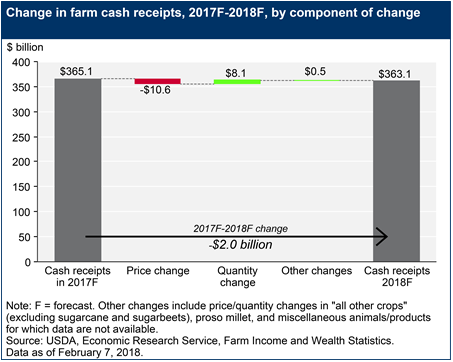 The US Department of Agriculture (USDA) recently reported its expectations for 2018 net farm income, which included a forecast for a $4.3 billion, or 6.7%, decline to $59.5 billion. At $59.5 billion, this represents the lowest nominal income level since 2006. Similarly, inflation-adjusted, or “real” dollar, net farm income is expected to decline $5.4 billion, or 8.3%, from 2017, which is the lowest real-dollar level since 2002. Net cash farm income, which differs from net farm income by excluding certain non-cash items such as depreciation, is forecasted to decrease $6.7 billion, or 6.8%.  Cash receipts for all commodities are expected to fall $2 billion, or 0.5%, to $363.1 billion. A 4.5% increase in soybean receipts will be offset by declines in corn, wheat, cotton, fruits and nuts, and vegetables and melons. Direct government payments to farms are forecast to decline $2.1 billion, or 18.6%, to $9.3 billion in 2018. Total production expenses are expected to increase $3.5 billion, or 1.0%, in nominal terms, to $359.2 billion in 2018. Increases in production expenses are led by fuel, interest, and hired labor, and partially offset by decreases in feed costs. Average net cash farm income is expected to experience its fourth consecutive decline to $93,200, which is the lowest average since 2011. Wheat and dairy farms are expected to experience double-digit declines. One area in which net cash farm income is expected to increase is cattle and calf farms, which are expected to experience a 6.2%, or $2,100, increase in average net cash farm income.
1 Comment
|
Archives
August 2019
Categories
All
|
|
Skyline Advisors is a division of Ideation Ventures, Inc. Services involving securities are offered through M&A Securities Group, Inc.4151 N Mulberry Drive Suite 252, Kansas City, MO, 64116 (“MAS") . Services involving real estate brokerage are offered through Berkshire Hathaway HomeServices Ambassador Real Estate ("BHHS"). Skyline, MAS, and BHHS are separate entities.
COPYRIGHT 2024. ALL RIGHTS RESERVED. |

 RSS Feed
RSS Feed
